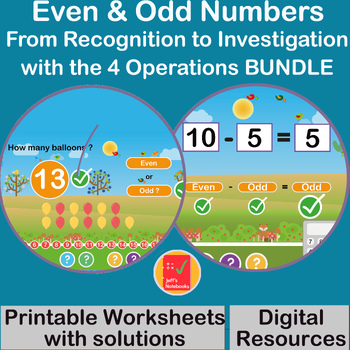Even and Odd Numbers - From Recognition to Patterns in the 4 Operations - BUNDLE
- Zip
- Easel Activity
- Easel Assessment
Products in this Bundle (2)
Description
This bundle combines investigating Even and Odd numbers from being able to recognise them to exploring patterns when you add, subtract, multiply or divide them with and without visual support.
Part 1: Recognise and identify even and odd numbers
This is one of the simplest ways to start exploring patterns in numbers. Beginning with counting and pairing objects it develops to recognising even and odd numbers according to the last (unit) digit in a number whatever it's size.
This pack includes (almost) unlimited printable NO PREP worksheets, Digital Teaching Resources, an Easel Activity and 2 Easel Assessments.
Worksheets Set 1 Up to 14 objects either in columns or arranged randomly, practicing counting in pairs and determining whether the number is even or odd.
Worksheets Set 2
Pupils use this worksheet to recognise even and odd numbers by simply looking at the last digit.
There are two levels; The first contains numbers up to 100, and the second, for an extra challenge, numbers up to 1000
Digital Teaching Page 1
Use pairing and/or counting, with objects in lines and arranged randomly (supports Worksheets Set 1)
Digital Teaching Page 2
Using 4 buttons you can randomly generate numbers at 4 levels: up to 30, 50, 100 or 1000 and get pupils to recognize whether they are even or odd by looking at the last digit. (supports Worksheets Set 2)
Easel Activity
7 "Drag and Drop" activities that follow the content of the Worksheets and Teaching Pages checking for even or odd numbers from balloons nicely arranged to numbers up to 1000 covering the content of both Worksheet Sets
Easel Assessments
2 Sets of True / False Assessments with 10 questions, one with the balloons and the other with numbers Worksheet Sets 1 and 2)
Part 2: Even and Odd Numbers: Investigating patterns with the four operations
This guides students through an exploration of patterns in our number system using the most fundamental classification of numbers - even and odd and the 4 operations.
There are two basic approaches to this investigation:
- With visual aids: Students can get visual clues when even and odd numbers of objects are displayed in an orderly fashion. Addition and Subtraction are covered here with worksheets and digital teaching resources. Multiplication has a digital teaching resource.
The range of numbers used are between 1 and 28 for addition, and 1 to 14 for subtraction.
For the multiplication the examples go from 2 x 2 to 6 x 7
- Without visual aids: students apply the idea learnt in the Grade 2 resource that whatever the size of the number, in the end only the last (unit) digit matters when deciding if a number is even or odd. Addition, subtraction, multiplication and division are all covered here.
The range of numbers used:
- Addition: 2-digit plus a 2-digit number up a total of 30, 50 or 100
- Subtraction: Two 2-digit numbers with the first number a maximum of 30, 50 or 100
- Multiplication: From 2 x 2 to 12 x 12
- Division: Dividend a maximum of 100, Divisor up to 12.
The work is organized into modules so that a step by step approach can be taken, and in fact the whole investigation including extension work suggested in the Guide could be spread throughout the whole year. Your students will learn to:
- Independently investigate and recognise any patterns or consistently repeated results when performing the 4 operations with even and odd numbers.
- Make generalizations from the work carried out.
- Make predictions and test them.
Part 1 and 2 are made up of Printable Worksheets and Digital Teaching Pages.
The Teaching Pages are interactive and designed as a whole class for use with an Interactive Whiteboard or on a computer for one to one tuition. Questions are randomized so lots of examples to practice with.
The Worksheets are dynamic. This means that at the click of a button the numbers in the questions are randomized so you can create an (almost) unlimited number of different worksheets for classwork, homework, assessments etc.
Note
These resources work with the official Adobe Acrobat Reader on Windows or Mac computers.





